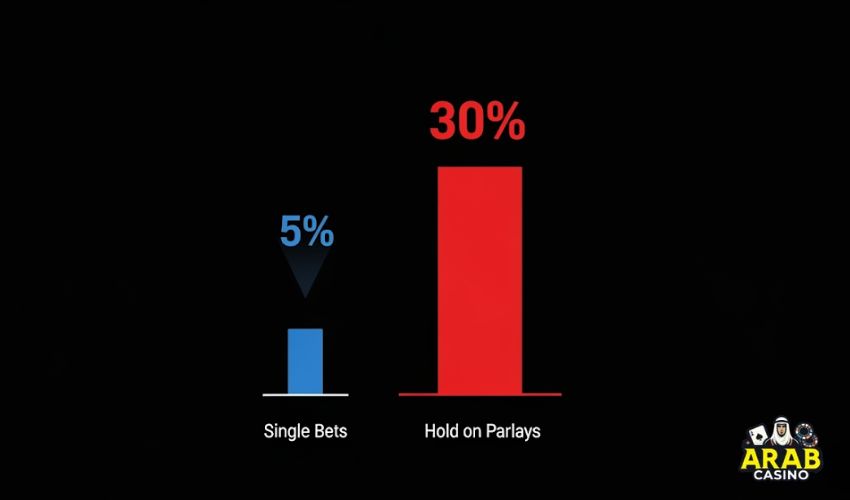How a Parlay Works: The Mechanics

Think of a parlay as an all-or-nothing chain of bets. You select multiple outcomes, perhaps the Los Angeles Lakers to win, the Kansas City Chiefs to cover the spread, and a hockey game to go over the total goals.
- You place a single stake on the combined outcome.
- The winnings from the first leg automatically roll over to become the stake for the second leg.
- This roll-over process continues for every leg in the parlay.
If all your selections are correct, you receive a significantly larger payout than if you had bet on each game individually. But the catch is absolute: a single incorrect pick means you lose your entire investment.
The main attraction of a parlay is the chance to win a large sum of money with a small initial risk. Because you are multiplying the odds together, the potential returns grow exponentially with each leg you add.
The Simple Way to Calculate Parlay Odds
While sportsbooks have automatic calculators, it is helpful to see how the math works. The core idea is converting American odds to decimal odds, multiplying them together, and then converting back. Let’s say you bet $10 on a 3-team parlay:
- Team A: -110 (Decimal odds: 1.91)
- Team B: +120 (Decimal odds: 2.20)
- Team C: -110 (Decimal odds: 1.91)
The calculation is: (1.91 x 2.20 x 1.91) x $10 Stake = $80.20 Payout
Your potential profit is $70.20. Had you bet $10 on each of these teams individually and all three won, your total profit would have been only $29.10. The parlay nearly tripled the potential profit, but it also introduced the condition that all three must win.
The Hidden Risks: Why Sportsbooks Love Parlays

Parlays are highly profitable for sportsbooks. The reason is the multiplied house edge, or “vig.” While a standard point spread bet has a house edge around 4.5%, that edge compounds with each leg of a parlay.
For bettors, this means the true probability of winning is lower than the payout suggests. According to data from the Nevada Gaming Control Board, the hold percentage for sportsbooks on parlays can often exceed 30%, a stark contrast to the 4-5% hold on individual football or basketball bets. This shows how much more difficult these wagers are to win consistently.
Types of Parlays You Will Encounter
The basic parlay concept has several popular variations.
Same-Game Parlays (SGPs)
A Same-Game Parlay combines multiple bets from a single contest. For example, in one NFL game, you could bet on:
- The quarterback to throw for over 2.5 touchdowns.
- A specific wide receiver to score a touchdown.
- The team to win the game.
SGPs are popular but have an important downside. Since the outcomes are often related (a QB throwing for many touchdowns makes it more likely his receiver scores), sportsbooks adjust the odds significantly. The final SGP payout is almost always lower than what a true odds calculation would be.
Teasers and Round Robins
- Teaser: A parlay where you get to adjust the point spread or total in your favor in exchange for a lower payout. This makes the individual legs easier to win.
- Round Robin: A way to hedge parlay risk. If you select three teams, a round robin places three separate 2-team parlays for you. This way, if only two of your three teams win, one of your parlays still cashes. Read more about Round Robin Betting.
My Perspective: When to Actually Consider a Parlay

Most professional bettors avoid standard parlays due to the poor value. However, one specific type can offer an edge: a correlated parlay. A correlated parlay links two events where one outcome increases the chance of the other. Many sportsbooks restrict these, but some slip through, especially in SGPs or player props.
Consider a Week 17 NFL game where a team must win to make the playoffs, and they are playing a team with nothing to play for that has already decided to rest its starters. A bettor might parlay the motivated team’s moneyline with the moneyline of another team playing in a different game.
In this case, the first leg is not correlated with the second in terms of on-field play, but the situational context (motivation) gives the bettor a perceived analytical edge on one leg, which they then attach to another straight bet.
The true art is finding a statistical correlation, such as a team’s strong first-half performance being highly predictive of their full-game result, and parlaying the first-half spread with the full-game spread if the odds offered are better than betting them separately.
Pros and Cons of Parlay Betting
| Pros | Cons |
| Potential for very large payouts | Extremely difficult to win |
| High entertainment value from a small stake | Significantly favors the sportsbook (high hold) |
| Allows for creative betting combinations | A single loss results in a total loss of the wager |
| Small initial investment required | Odds are often worse than the true probability suggests |
A Final Cautionary Note for Bettors
The primary appeal of the parlay is psychological. It feels like buying a lottery ticket—a small price for a chance at a life-altering score. Sportsbooks market these bets heavily for that very reason. They capitalize on the human desire for a shortcut to wealth.
Before placing a parlay, ask yourself if you are making a calculated wager or simply buying a ticket for the thrill. A disciplined bettor understands that long-term success is built on finding consistent value in single bets, not chasing improbable windfalls.





